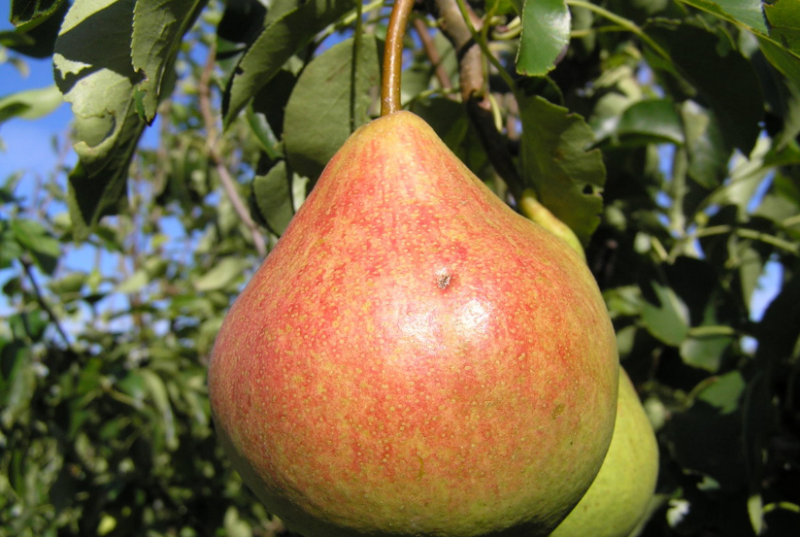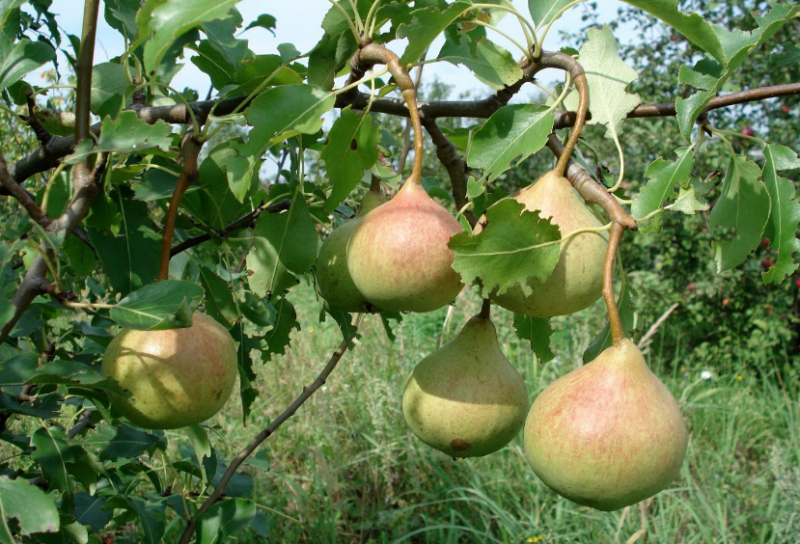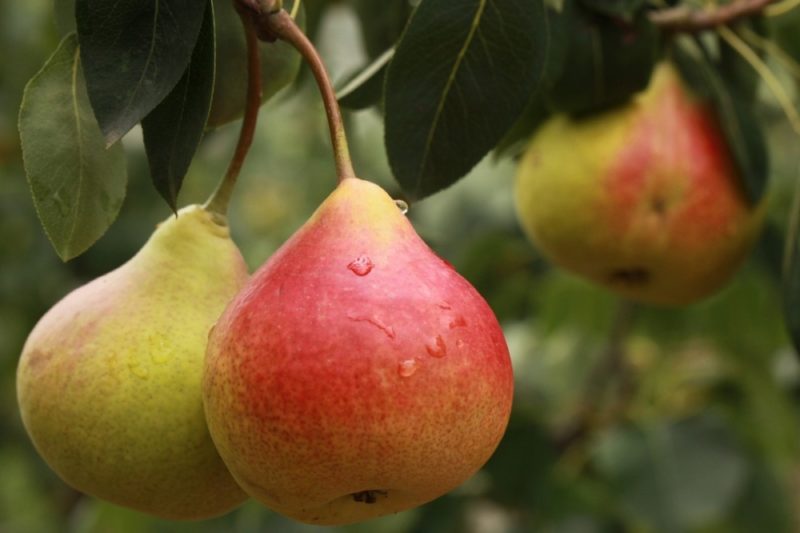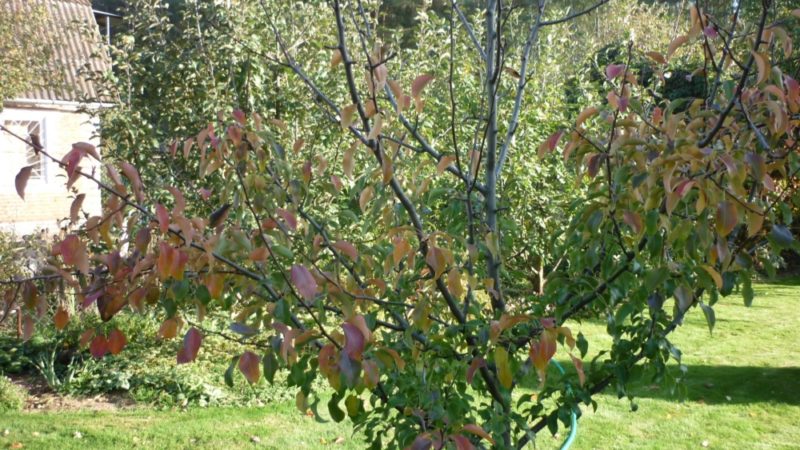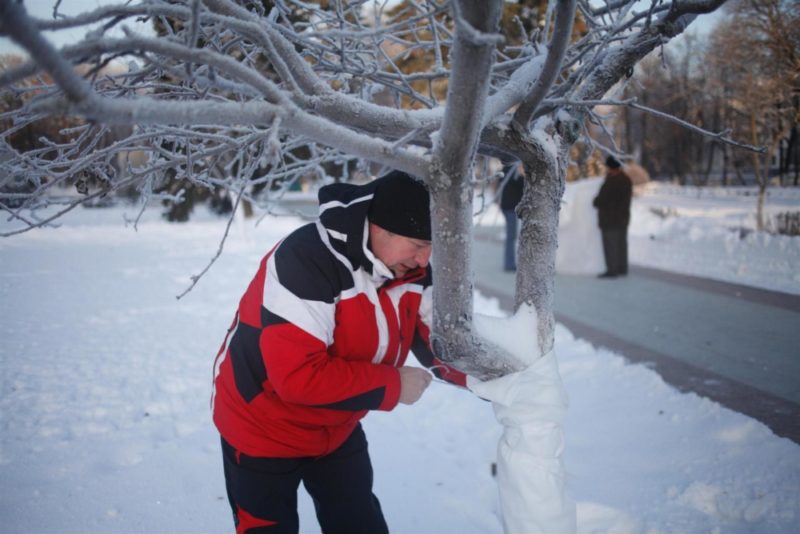Once upon a time, a limited number of species of fruit plants grew in Russian gardens. But the science involved in breeding did not stand still. And soon at the Institute named after I.V. Michurin was bred a new variety of pears: "In memory of Yakovlev."
Material Content:
Description of the variety “In memory of Yakovlev”
This species is perfect for breeding in a temperate continental climate, characterized by frosty winters and humid summers. It is grown in almost all regions of Central Russia.
The tree grows fast enough, not reaching a high height. Self-fertile, with a rounded crown of medium density. Branches grow at right angles.
Variety Description:
- Well-developed ability to form new shoots.
- Fruit formations are simple and complex.
- Shoots of a brownish tint.
- Leaves of medium size.
- Separate white flowers with smooth edges.
- The fruits are broad in shape, have a light yellow color.
- The pulp is sweet, without a tart aftertaste.
- Resistant to scab.
Ripening occurs in late summer and early fall. Then you can start harvesting. Ripe fruits are stored for a couple of weeks. Due to the high density of the pulp, the fruit is suitable for long transport.
Fruiting occurs after 3 years. The variety is characterized by high productivity. From one tree it is possible to collect about 20 - 30 kg of fruit.
It tolerates severe frosts. Even after prolonged frosts it quickly recovers.
Pear is demanding for watering. Proper care directly affects the taste of the fetus.
Planting in the garden
When choosing seedlings, special attention should be paid to their appearance. They must be absolutely healthy. You should not make a decision, focusing only on a photo on the Internet or a catalog. It is necessary to conduct a thorough visual inspection in reality: whether there are black spots, traces of decay, dried bark.
Planted prepared material in loose dry soil in the area with high light availability, without shading. Only fertile soil types are suitable. But do not forget about fertilizer.
Landing is carried out in the spring. Saplings are dug in fertilized soil immediately. The plant does not tolerate frequent transplantation. They seek one place - once and for all. The height of the tree is small, so the seedlings can be placed tightly to each other.
For landing, you will need a deep wide pit with a diameter of 100 cm (1 m) and a height of 120 cm (1.2 m). Fertilizers are applied immediately, humus, sand, potassium sulfate and superphosphate are suitable. A mixture of dolomite flour and lime is also made in water. This composition is watered and left for 5-7 days.
After the designated period, you can proceed to the immediate landing. In the middle of the pit, a peg is dug, a little longer than a seedling in length. Further, the place is lightly sprinkled with earth, gently lower the tree there and the roots fall asleep. The soil is compacted and watered abundantly. Usually enough about a pair of buckets.
Outdoor cultivation and care
Cultivation requires certain skills and knowledge of the principles of agricultural technology:
- Watering. For full growth and development, young seedlings must be regularly watered. To do this, grooves with a diameter of 40 cm are formed around the trunk, where several buckets of water are poured. The procedure is repeated after 20 days. The plant especially needs to be thoroughly moistened during the dry period.
- Pruning. To ensure abundant fruiting, it is necessary to carry out the correct pruning of the pear, shortening the main shoot 60 cm from the ground. Next year, as a result of such processing, new lateral branches will appear, which should be cut by a quarter in spring.
- Fertilizers Potassium and phosphorus additives with an organic mixture are suitable as fertilizers. Feeding should be done every 5 years. Also, simultaneously with spring loosening, nitrogen fertilizers are often applied to ensure better growth and ripening of fruits.
- Shelter for the winter. This variety is frost-resistant, but still needs winter protection. To do this, the tree is wrapped in white paper or cloth. Sometimes another method is used: the near-stem circle is filled with water and with the onset of cold weather it is covered with ice, protecting the root system from frost. In addition, mulch in the form of dry leaves, sawdust, ash or peat helps the plant survive the winter without consequences.
Fruit ripening period
If the pear was planted correctly and proper care is provided, fruiting occurs quickly. After three years, it is possible to get a full crop. Ripening begins in late August. And you can collect in September.
The fruit does not have a strong aroma, tastes sweet with a slight acidity, small size, weight - about 140 g. The shape is round with a pronounced ribbing.
Maturity varies by region. Soil quality and rainfall also have an effect. With their shortage, the tree needs regular watering.
Propagation Features
To preserve maternal properties in new plantings, it is necessary to propagate the culture by layering.
To this end, it should:
- Choose a branch, bend it to a pre-prepared box of earth (lay polyethylene at the bottom, which contributes to the accumulation of moisture).
- Then cut it in several places and sprinkle with soil. For better engraftment, you can use "Epin".
- The box should be covered with something: with a film or roofing material.
- It is necessary to maintain a moist environment at all times.
- In winter, the structure must be covered with snow.
The seedling is grown within two years, after which it is separated from the main tree and planted.
This method is very effective. All maternal properties are preserved, and the tree itself begins to bear fruit well.
The variety “In memory of Yakovlev” is considered one of the most popular among gardeners due to its unpretentiousness. Even pruning a pear does not require special skills. The crown is formed naturally, and therefore it is not worth trimming it too much. Only frozen branches are deleted.
Harvesting and storage
Ripened fruits can hang on branches for quite some time and not crumble. Therefore, with the harvest, you can not rush. It is better to do this in good weather closer to dinner, when the pear dries from morning dew.
Those fruits that hang low are picked by hands. For those who are quite high they use special fruit collectors and stairs. Next, you need to sort. Damaged or damaged fruits are sent for processing or eat them soon.
Good fruits can be stored without special equipment for about two weeks. For longer storage, a cool room with a temperature of up to + 5 ° C is required.
Pears are placed in boxes with good ventilation. Thus, they are able to lie for about 2 months.
If the humidity in the room is exceeded, then you can fix this with ordinary lime. To do this, they put it in several buckets, which are placed near the boxes, periodically changing.
Pest and Disease Control
This culture is quite resistant to disease. Timely measures to prevent them significantly increase the immunity of the tree. They process the pear in the spring until the flowers bloom, and then in the autumn, after leaf fall. The most common means are Bordeaux mixture and copper sulfate.
Also, plant endurance can be increased using special methods:
- Cleaning trunks from the old bark, their whitewashing.
- Timely cleaning of diseased foliage and rotten fruits.
- Digging the ground in the autumn.
- Treatment of trunks with garden vari for minor injuries.
But sometimes even these methods do not save the tree. In this case, you need to act quickly so that the disease or pests can not cause tangible harm and disrupt the formation of fruits.
- A disease such as black cancer is often found in this culture. It develops at a slow pace and cannot always be seen. First, small cracks appear on the cortex, which begin to grow. Affected areas look charred. They should be cut with a sharp knife and treated with 3% copper sulfate solution.
- Rust appears on the leaves. They become uneven with rusty spots. A black dot forms in the center, and several tubercles - the mycelium - depart from it. Then the diseased leaves dry and fall. Drugs fighting the fungus will help to get rid of: “Skor”, “Chorus”, “Abiga-Peak”.
- Among pests, a pear most often attacks aphids. Insects suck out nutrients from it, thereby weakening growth and fruiting. You can fight with the help of the drug "Actellik" before flowering, or after, using "Iskra-Bio."
The variety “In memory of Yakovlev” is very resistant to other diseases, for which he found the universal love of gardeners. Moreover, it blooms profusely, without requiring additional pollinators due to the ability to self-pollination.
Preparing the pear for winter
The tree easily tolerates even severe cold. Therefore, it is not necessary to cover it additionally. It is only necessary to protect the trunk circle with snow.
Additional assistance should be given to young seedlings. The roots are covered with a layer of mulch (about 20 cm). The trunk and branches - any breathable material.
The most dangerous phenomenon in the winter is rodents. So that they do not gnaw through the trunk, it is closed with a special mesh.
The self-made pear variety is one of the most popular and favorite in Russia.A huge number of advantages make it number one in the number of landings among the other varieties. Moreover, the fruits have universal application - they are tasty both in fresh and in any processed form.



